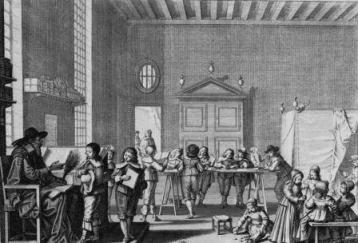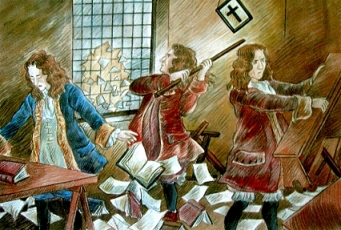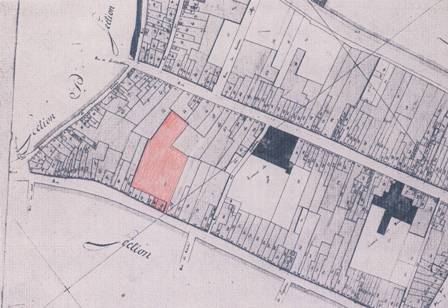The setting up of Jean-Baptiste de La Salle, with his teachers, Rue Neuve 1682-1719
 A
t that time, schools were held by ‘’Writing Masters -’’. They were not free. The poor had no access to them.
As in all the small schools, the pupils learned to read in Latin. "Before to be put into the French reading section,
the children have to know well how to read in Latin in any sorts of books, because this reading is the foundation
of the French language. As it contains the same characters and syllables, and if we have to show to a child to
read in Latin and in French in any group, it would be a hard job for the Master."
A
t that time, schools were held by ‘’Writing Masters -’’. They were not free. The poor had no access to them.
As in all the small schools, the pupils learned to read in Latin. "Before to be put into the French reading section,
the children have to know well how to read in Latin in any sorts of books, because this reading is the foundation
of the French language. As it contains the same characters and syllables, and if we have to show to a child to
read in Latin and in French in any group, it would be a hard job for the Master."
I t was an individual teaching. In the system of individual teaching, the schedule of the school is reduced to its simplest expression: Teachers had just to indicate the time to begin and end work. Between these two limits, he dedicated itself successively to his pupils. In fact - and we imagine it easily - he had little time to dedicate to each and time limits remained rather vague for them.
S ome parish priests had been moved by these conditions, and they had opened the "schools of charity ", sorts of day nurseries or protected workshops. These schools were free, but to avoid children idleness out of the time reserved for teaching and catechism, working hours were imposed on them, especially sewing or weaving. Teachers were chosen by the Priest. Most of them were uneducated, not trained in their teacher’s' profession, which was little considered and little paid. They were poor men among poor people, often as rude as their pupils.
W ho were these poorest people of France? They were soldiers, laborers, lackeys, shepherds and other servants... To those , we must add the various assistants, and all the barbers, apothecaries, innkeepers, water carriers, peddlers, as well as the workers and the skilled and unskilled workers. All of them, and generally all the poor, poorly educated, were busy all day long, working hard to make their living and their family’s. The daily working hours varied from 12 to 16. Men and women were obliged to work to survive. How, in these conditions, would they have been able to take care of their children? They had even no hope to see their children coming through and acquiring a minimum of professional qualification, because training was generally not free. Let us add that numerous poor children of the lower classes, were hired in factories from six or seven, and for derisive salaries.
 "These poor children of both sexes are tramps who roam the streets, who just know how to play, make naughty tricks, fight and quarrel... These children who appear in
the church just to disturb and make scandals, these children who by growing, become swearers, drunkards, professional libertines, true sons of irreligious ,unreasonable
fathers. So these children, familiarized with vice and almost naturalized with it, do not any more perceive evil and loose the horror of it while growing up. "
"These poor children of both sexes are tramps who roam the streets, who just know how to play, make naughty tricks, fight and quarrel... These children who appear in
the church just to disturb and make scandals, these children who by growing, become swearers, drunkards, professional libertines, true sons of irreligious ,unreasonable
fathers. So these children, familiarized with vice and almost naturalized with it, do not any more perceive evil and loose the horror of it while growing up. "
T hanks to the support of Canon de La Salle, soon opened two schools, on Saint- Maurice and Saint Jacques parishes.
The writing program was very ambitious. Masters did not insist on spontaneous writing, which was obvious, but concentrated on the calligraphy which developed through 8 Orders of ‘’round writing’’ and 5 Orders of ‘’block writing.’’
La Salle opted resolutely for French and allowed the reading in Latin only for two months in the school program, and only when "the pupils are well able to read in French ".
The writing program was very ambitious. Masters did not insist on spontaneous writing, which was obvious, but concentrated on the calligraphy which developed through 8 Orders of ‘’round writing’’ and 5 Orders of ‘’block writing.’’

T his program clearly encroached upon the reserved territory of the Writing-Masters, which produced serious conflicts between the Brothers Schools and this Corporation, going up to the wreckage of schools and to proceedings where De La Salle was condemned. In spite of that, he never gave up, because he thought that this training brought a major professional asset to the pupils.
 O
n June 24th 1682, Jean-Baptiste de La Salle settled down, with his masters, in a house that he rented Rue Neuve. The school of Saint-Etienne Parish, opened in 1679,
rue Marguerite, in a building close to the house of the de La Salle family, was transferred Rue Neuve.
O
n June 24th 1682, Jean-Baptiste de La Salle settled down, with his masters, in a house that he rented Rue Neuve. The school of Saint-Etienne Parish, opened in 1679,
rue Marguerite, in a building close to the house of the de La Salle family, was transferred Rue Neuve.
I n 1684, Jean-Baptiste de La Salle proposed a community life to his masters. Since then they took the name of "Brothers of the Christian Schools ".
 O
n August 11th 1700, Jean-Baptiste de La Salle bought the two houses, Rue Neuve, which he occupied as a lodger before.
O
n August 11th 1700, Jean-Baptiste de La Salle bought the two houses, Rue Neuve, which he occupied as a lodger before.
T o secure the maintenance of the Christian Schools, to ensure the material existence of the Brothers of the Reims community and the survival of the work, many persons, priests, canons, magistrates, middle-class traders, widows and relatives of de La Salle, bequeathed, by will, money, buildings and even farms to the Brothers of the Christian Schools.